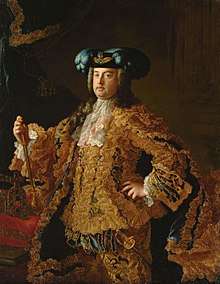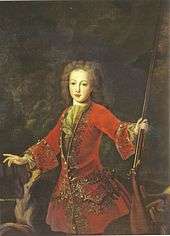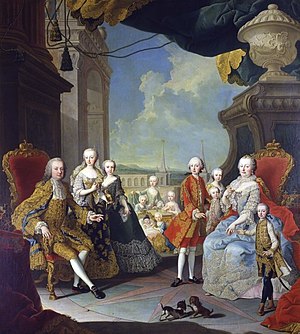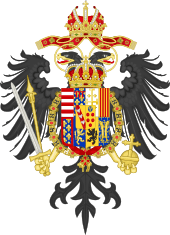Francis I, Holy Roman Emperor
Francis I (Francis Stephen; German: Franz Stefan; French: François Étienne; 8 December 1708 – 18 August 1765)[1] was Duke of Lorraine and Bar, positions that he later exchanged for that of Grand Duke of Tuscany, who came to marry Maria Theresa of Austria and become Holy Roman Emperor, though his wife effectively executed the real powers. They were the founders of the Habsburg-Lorraine dynasty. The oldest surviving son of the Duke of Lorraine, Francis left the duchy for the deposed Polish king Stanisław Leszczyński in exchange for the Grand Duchy of Tuscany as one of the terms ending the War of the Polish Succession in 1738. The duchy and the ducal title to Lorraine and Bar passed to King Louis XV of France upon Leszczynski's death in 1766, though Francis and his successors retained the right to style themselves as dukes of Lorraine and Bar.
| Francis I | |||||
|---|---|---|---|---|---|
 Portrait by Martin van Meytens, 1745. | |||||
| Holy Roman Emperor (jure uxoris) King in Germany | |||||
| Reign | 13 September 1745 – 18 August 1765 | ||||
| Coronation | 4 October 1745, Frankfurt | ||||
| Predecessor | Charles VII | ||||
| Successor | Joseph II | ||||
| Archduke of Austria | |||||
| Reign | 21 November 1740 – 18 August 1765 | ||||
| Predecessor | Maria Theresa | ||||
| Successor | Joseph II | ||||
| Co-monarch | Maria Theresa | ||||
| Grand Duke of Tuscany | |||||
| Reign | 12 July 1737 – 18 August 1765 | ||||
| Predecessor | Gian Gastone | ||||
| Successor | Leopold I | ||||
| Duke of Lorraine | |||||
| Reign | 27 March 1729 – 9 July 1737/18 August 1765 (titular only) | ||||
| Predecessor | Leopold | ||||
| Successor | Stanisław I | ||||
| Born | 8 December 1708 Ducal Palace of Nancy, Lorraine, Holy Roman Empire | ||||
| Died | 18 August 1765 (aged 56) Palace of Innsbruck, Austria | ||||
| Burial | |||||
| Spouse | |||||
| Issue |
| ||||
| |||||
| House | Lorraine | ||||
| Father | Leopold, Duke of Lorraine | ||||
| Mother | Élisabeth Charlotte d'Orléans | ||||
| Religion | Roman Catholicism | ||||
| Signature | |||||
Early life
Francis was born in Nancy, Lorraine (now in France), the oldest surviving son of Leopold, Duke of Lorraine, and his wife Princess Élisabeth Charlotte d'Orléans. He was connected with the Habsburgs through his grandmother Eleonore, daughter of Emperor Ferdinand III. He was very close to his brother Charles and sister Anne Charlotte.
Emperor Charles VI favoured the family, who, besides being his cousins, had served the house of Austria with distinction. He had designed to marry his daughter Maria Theresa to Francis' older brother Leopold Clement. On Leopold Clement's death, Charles adopted the younger brother as his future son-in-law. Francis was brought up in Vienna with Maria Theresa with the understanding that they were to be married, and a real affection arose between them.
At the age of 15, when he was brought to Vienna, he was established in the Silesian Duchy of Teschen, which had been mediatised and granted to his father by the emperor in 1722. Francis succeeded his father as Duke of Lorraine in 1729. In 1731 he was initiated into freemasonry (Grand Lodge of England) by John Theophilus Desaguliers at a specially convened lodge in The Hague at the house of the British Ambassador, Philip Stanhope, 4th Earl of Chesterfield.[2] During a subsequent visit to England, Francis was made a Master Mason at another specially convened lodge at Houghton Hall, the Norfolk estate of British Prime Minister Robert Walpole.[3]

Maria Theresa arranged for Francis to become "Lord Lieutenant" (locumtenens) of Hungary in 1732. He was not excited about this position, but Maria Theresa wanted him closer to her. In June 1732 he agreed to go to Pressburg.
When the War of the Polish Succession broke out in 1733, France used it as an opportunity to seize Lorraine, since France's prime minister, Cardinal Fleury, was concerned that, as a Habsburg possession, it would bring Austrian power too close to France.
A preliminary peace was concluded in October 1735 and ratified in the Treaty of Vienna in November 1738. Under its terms, Stanisław I, the father-in-law of King Louis XV and the losing claimant to the Polish throne, received Lorraine, while Francis, in compensation for his loss, was made heir to the Grand Duchy of Tuscany, which he would inherit in 1737.
Although fighting stopped after the preliminary peace, the final peace settlement had to wait until the death of the last Medici Grand Duke of Tuscany, Gian Gastone de' Medici in 1737, to allow the territorial exchanges provided for by the peace settlement to go into effect.
In March 1736 the Emperor persuaded Francis, his future son-in-law, to secretly exchange Lorraine for the Grand Duchy of Tuscany. France had demanded that Maria Theresa's fiancé surrender his ancestral Duchy of Lorraine to accommodate the deposed King of Poland. The Emperor considered other possibilities (such as marrying her to the future Charles III of Spain) before announcing the engagement of the couple. If something were to go wrong, Francis would become governor of the Austrian Netherlands.
Elisabeth of Parma had also wanted the Grand Duchy of Tuscany for her son Charles III of Spain; Gian Gastone de' Medici was childless and was related to Elisabeth via her great-grandmother Margherita de' Medici. As a result, Elisabeth's sons could claim by right of being a descendant of Margherita.
On 31 January 1736 Francis agreed to marry Maria Theresa. He hesitated three times (and laid down the feather before signing). Especially his mother Élisabeth Charlotte d'Orléans and his brother Prince Charles Alexander of Lorraine were against the loss of Lorraine. On 1 February, Maria Theresa sent Francis a letter: she would withdraw from her future reign, when a male successor for her father appeared.
Marriage

They married on 12 February in the Augustinian Church, Vienna. The wedding was held on 14 February 1736. The (secret) treaty between the Emperor and Francis was signed on 4 May 1736. On 5 January 1737, instruments of cession were signed at Pontremoli between Spain and the Empire, with Spain ceding Parma, Piacenza and Tuscany to the Holy Roman Empire and the Empire recognizing Don Carlos of Spain as King of Naples and Sicily.[4] On 10 January, the Spanish troops began their withdrawal from Tuscany, and were replaced by 6,000 Austrians.[5] On 24 January 1737 Francis received Tuscany from his father-in-law.[6] Until then, Maria Theresa was Duchess of Lorraine.
Gian Gastone de' Medici, who died on 9 July 1737, was the second cousin of Francis (Gian Gastone and Francis' father Leopold were both great-grandchildren of Francis II, Duke of Lorraine), who also had Medici blood through his maternal great-great-grandmother Marie de' Medici, Queen consort of France and Navarre. In June 1737 Francis went to Hungary again to fight against the Turks. In October 1738 he was back in Vienna. On 17 December 1738 the couple travelled south, accompanied by his brother Charles to visit Florence for three months. They arrived on 20 January 1739.
In 1744 Francis' brother Charles married a younger sister of Maria Theresa, Archduchess Maria Anna of Austria. In 1744 Charles became governor of the Austrian Netherlands, a post he held until his death in 1780.
Reign
Maria Theresa secured in the Treaty of Füssen his election to the Empire on 13 September 1745, in succession to Charles VII, and she made him co-regent of her hereditary dominions.
Francis was well content to leave the wielding of power to his able wife. He had a natural fund of good sense and brilliant business capacity and was a useful assistant to Maria Theresa in the laborious task of governing the complicated Austrian dominions, but he was not active in politics or diplomacy. However, his wife left him in charge of the financial affairs, which he managed well until his death.[7] Heavily indebted and on the verge of bankruptcy at the end of the Seven Years' War, the Austrian Empire was in a better financial condition than France or England in the 1780s. He also took a great interest in the natural sciences.
Francis was a serial adulterer, many of his affairs well-known and indiscreet, notably one with Maria Wilhelmina, Princess of Auersperg, who was thirty years his junior. This particular affair was remarked upon in the letters and journals of visitors to the court and in those of his children.[8]
He died suddenly in his carriage while returning from the opera at Innsbruck on 18 August 1765. He is buried in tomb number 55 in the Imperial Crypt in Vienna.
Maria Theresa and Francis I had sixteen children, amongst them the last pre-revolutionary queen consort of France, their youngest daughter, Marie Antoinette (1755–1793). Francis was succeeded as Emperor by his eldest son, Joseph II, and as Grand Duke of Tuscany by his younger son, Peter Leopold (later Emperor Leopold II). Maria Theresa retained the government of her dominions until her own death in 1780.
Issue
| № | Name | Birth | Death | Notes |
|---|---|---|---|---|
| 1 | Archduchess Maria Elisabeth of Austria | 5 February 1737 | 6 June 1740 | died in childhood, no issue |
| 2 | Archduchess Maria Anna | 6 October 1738 | 19 November 1789 | died unmarried, no issue |
| 3 | Archduchess Maria Carolina of Austria | 12 January 1740 | 25 January 1741 | died in childhood likely from smallpox, no issue |
| 4 | Holy Roman Emperor Joseph II | 13 March 1741 | 20 February 1790 | married 1) Princess Isabella Maria of Parma (1741–1763), married 2) Princess Marie Josephe of Bavaria (1739–1767) – second cousin, had issue from his first marriage (two daughters, who died young) |
| 5 | Archduchess Maria Christina of Austria | 13 May 1742 | 24 June 1798 | married Prince Albert of Saxony, Duke of Teschen (1738–1822), her second cousin, had issue (one stillborn daughter) |
| 6 | Archduchess Maria Elisabeth of Austria | 13 August 1743 | 22 September 1808 | died unmarried, no issue |
| 7 | Archduke Charles Joseph of Austria | 1 February 1745 | 18 January 1761 | died of smallpox, no issue |
| 8 | Archduchess Maria Amalia of Austria | 26 February 1746 | 9 June 1804 | married Ferdinand, Duke of Parma (1751–1802), had issue. |
| 9 | Holy Roman Emperor Leopold II | 5 May 1747 | 1 March 1792 | married Infanta Maria Luisa of Spain (1745–1792), had issue. Grand Duke of Tuscany from 1765 (abdicated 1790), Holy Roman Emperor from 1790, Archduke of Austria, King of Hungary and King of Bohemia from 1790. |
| 10 | Archduchess Maria Carolina of Austria | 17 September 1748 | 17 September 1748 | died hours after baptism |
| 11 | Archduchess Maria Johanna of Austria | 4 February 1750 | 23 December 1762 | died of smallpox, no issue |
| 12 | Archduchess Maria Josepha of Austria | 19 March 1751 | 15 October 1767 | died of smallpox, no issue |
| 13 | Archduchess Maria Carolina of Austria | 13 August 1752 | 7 September 1814 | married King Ferdinand IV of Naples and Sicily (1751–1825); had issue |
| 14 | Archduke Ferdinand of Austria | 1 June 1754 | 24 December 1806 | married Maria Beatrice d'Este, Duchess of Massa, heiress of Breisgau and of Modena, had issue (Austria-Este). Duke of Breisgau from 1803. |
| 15 | Archduchess Maria Antonia of Austria | 2 November 1755 | 16 October 1793 | married Louis XVI of France and Navarre (1754–1793) and became Marie Antoinette, Queen of France and Navarre. |
| 16 | Archduke Maximilian Franz of Austria | 8 December 1756 | 27 July 1801 | Archbishop-Elector of Cologne, 1784. |
Ancestry
| Ancestors of Francis I, Holy Roman Emperor[9] | ||||||||||||||||||||||||||||||||||||||||||||||||||||||||||||||||||||||||||||||||||||||||||||||||||||||||||||||||||||||||||||||||||||||||||||||||||||||||||||||||||||||||||||||||||||||||||||||||||||||||||||||||||||||||||||||||||||||||||||||||||||||||||||||||||||||||||||||||||||||||||||||||||||||||||||||||||||||||||||||||||||||||||||||||||||||||||||||||||||||||||||||||||||||||||||||||||||||||||||||||||||||||||||||||||||||||||||||||||||||||||||||||||||||||||||||||||||||||||||||||||||||||||||||||||||||||||||||||||||||||||||||||||||||||||||||||||||||||||||||||||||||||||||||||||||||||||||||||
|---|---|---|---|---|---|---|---|---|---|---|---|---|---|---|---|---|---|---|---|---|---|---|---|---|---|---|---|---|---|---|---|---|---|---|---|---|---|---|---|---|---|---|---|---|---|---|---|---|---|---|---|---|---|---|---|---|---|---|---|---|---|---|---|---|---|---|---|---|---|---|---|---|---|---|---|---|---|---|---|---|---|---|---|---|---|---|---|---|---|---|---|---|---|---|---|---|---|---|---|---|---|---|---|---|---|---|---|---|---|---|---|---|---|---|---|---|---|---|---|---|---|---|---|---|---|---|---|---|---|---|---|---|---|---|---|---|---|---|---|---|---|---|---|---|---|---|---|---|---|---|---|---|---|---|---|---|---|---|---|---|---|---|---|---|---|---|---|---|---|---|---|---|---|---|---|---|---|---|---|---|---|---|---|---|---|---|---|---|---|---|---|---|---|---|---|---|---|---|---|---|---|---|---|---|---|---|---|---|---|---|---|---|---|---|---|---|---|---|---|---|---|---|---|---|---|---|---|---|---|---|---|---|---|---|---|---|---|---|---|---|---|---|---|---|---|---|---|---|---|---|---|---|---|---|---|---|---|---|---|---|---|---|---|---|---|---|---|---|---|---|---|---|---|---|---|---|---|---|---|---|---|---|---|---|---|---|---|---|---|---|---|---|---|---|---|---|---|---|---|---|---|---|---|---|---|---|---|---|---|---|---|---|---|---|---|---|---|---|---|---|---|---|---|---|---|---|---|---|---|---|---|---|---|---|---|---|---|---|---|---|---|---|---|---|---|---|---|---|---|---|---|---|---|---|---|---|---|---|---|---|---|---|---|---|---|---|---|---|---|---|---|---|---|---|---|---|---|---|---|---|---|---|---|---|---|---|---|---|---|---|---|---|---|---|---|---|---|---|---|---|---|---|---|---|---|---|---|---|---|---|---|---|---|---|---|---|---|---|---|---|---|---|---|---|---|---|---|---|---|---|---|---|---|---|---|---|---|---|---|---|---|---|---|---|---|---|---|---|---|---|---|---|---|---|---|---|---|---|---|---|---|---|---|---|---|---|---|---|---|---|---|---|---|---|---|---|---|---|---|---|---|---|---|---|---|---|---|---|---|---|---|---|---|---|---|---|---|---|---|---|---|---|---|---|---|---|---|---|---|---|---|---|---|---|---|---|---|---|---|---|---|---|---|---|---|---|---|---|---|---|---|---|---|---|---|---|---|---|---|---|---|---|---|---|---|---|---|---|---|---|---|---|---|---|---|---|---|---|---|---|---|---|---|---|---|---|---|---|---|---|---|---|---|---|---|---|---|---|---|---|---|---|---|---|---|---|---|---|---|---|---|---|
| ||||||||||||||||||||||||||||||||||||||||||||||||||||||||||||||||||||||||||||||||||||||||||||||||||||||||||||||||||||||||||||||||||||||||||||||||||||||||||||||||||||||||||||||||||||||||||||||||||||||||||||||||||||||||||||||||||||||||||||||||||||||||||||||||||||||||||||||||||||||||||||||||||||||||||||||||||||||||||||||||||||||||||||||||||||||||||||||||||||||||||||||||||||||||||||||||||||||||||||||||||||||||||||||||||||||||||||||||||||||||||||||||||||||||||||||||||||||||||||||||||||||||||||||||||||||||||||||||||||||||||||||||||||||||||||||||||||||||||||||||||||||||||||||||||||||||||||||||
Titles

Francis I, by the grace of God elected Holy Roman Emperor, forever August, King in Germany and of Jerusalem, Archduke of Austria, Duke of Lorraine, Bar, and Grand Duke of Tuscany, Duke of Calabria, in Silesia of Teschen, Prince of Charleville, Margrave of Pont-à-Mousson and Nomeny, Count of Provence, Vaudémont, Blâmont, Zütphen, Saarwerden, Salm, Falkenstein, etc. etc.
Award
The Francis Stephen Award pays homage to the interest that Francis I had in science, arts and culture of Austria. It honors works of excellence in the 18th century or the Habsburg monarchy. The award gives rise to the award of a diploma at a ceremony at the University of Vienna.
See also
- Franz Joseph Toussaint
- Kings of Germany family tree
- List of people with the most children
- Francis Stephen Award
References
- Encyclopedia of Austria: Franz I
- Audrey Carpenter, John Theophilus Desaguliers: A Natural Philosopher, Engineer and Freemason in Newtonian England, (London : Continuum, 2011), ISBN 978-1-4411-2778-5, p. 47
- Maclolm Davies, The masonic muse : songs, music, and musicians associated with Dutch freemasonry, 1730–1806. (Utrecht : Koninklijke Vereniging voor Nederlandse Muziekgeschiedenis, 1995), ISBN 90-6375-199-0, pp. 22–23
- Hargreaves-Mawdsley, W. N., Eighteenth-Century Spain 1700–1788: A Political, Diplomatic and Institutional History. Palgrave Macmillan UK. London, 1979. ISBN 978-1-349-01805-5
- Hale, Florence and the Medici, Orion books, p 192. London, 1977, ISBN 1-84212-456-0.
- Maria Theresia und ihre Zeit. Exhibition from 13 May till October 1980 in Vienna, Schloss Schönbrunn, p. 28, see also pp. 37, 38, 41, 47, 52, 53 for the other details described here.
- Maria-Theresa, Jean-Paul Bled
- Farquhar, Michael (2001). A Treasure of Royal Scandals, p.89. Penguin Books, New York. ISBN 0-7394-2025-9.
- Genealogie ascendante jusqu'au quatrieme degre inclusivement de tous les Rois et Princes de maisons souveraines de l'Europe actuellement vivans [Genealogy up to the fourth degree inclusive of all the Kings and Princes of sovereign houses of Europe currently living] (in French). Bourdeaux: Frederic Guillaume Birnstiel. 1768. p. 81.
External links

- Tomáš Kleisner – Jan Boublík, Coins and Medals of the Emperor Francis Stephen of Lorraine Prague 2011 ISBN 978-80-7036-316-4

Francis I, Holy Roman Emperor Born: 8 December 1708 Died: 18 August 1765 | ||
| Regnal titles | ||
|---|---|---|
| Preceded by Gian Gastone de' Medici |
Grand Duke of Tuscany 1737–1765 |
Succeeded by Leopold II |
| Preceded by Leopold |
Duke of Lorraine 1729–1737 |
Succeeded by Stanisław I |
| Duke of Teschen 1729–1765 |
Succeeded by Joseph II | |
| Preceded by Charles VII |
King in Germany 1745–1764 | |
| Holy Roman Emperor 1745–1765 | ||
| Preceded by Maria Theresa as sole ruler |
Archduke of Austria Ruler of the Austrian Netherlands 21 November 1740–1765 with Maria Theresa |
Succeeded by Maria Theresa as sole ruler |
